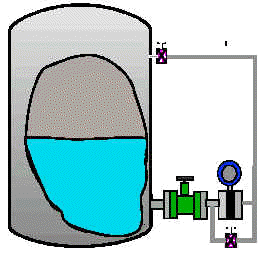Perhaps the most frequently used device for the measurement of level is a differential pressure transmitter. Using DP for level is really an inferential measurement.
A DP is used to transmit the head pressure that the diaphragm senses due to the height of the material in the vessel multiplied by a density variable.
Differential Pressure Level Sensor Theory,

Advantages
The primary benefit of DP’s is that it can be externally installed or retrofitted to an existing vessel. It can also be isolated safely from the process using block valves for maintenance and testing.
There are certain measurements such as total level in separator vessels that due to wide variations in material composition of the upper phase DP is the only viable if not ideal option.
Disadvantages
D/P transmitters are subject to errors due to changes in liquid density. Density variations are caused by temperature changes or change of product. These variations must always be compensated for if accurate measurements are to be made.
DP’s are mainly intended for clean liquids and require two vessel penetrations. One is near the bottom of the vessel where leak paths are the cause of the majority of problems. D/P’s should not be used with liquids that solidify as their concentrations increase.
An example is paper pulp stock.
Practical Notes
Fluid density must be stable if readings are to be accurate. If liquid density is subject to change a second d/p transmitter is required to measure density and then used to
compensate for any changes. To accommodate the measurement of light slurries, differential pressure transmitters are available with extended diaphragms that fit flush to the side of the vessel. However, if the d/p transmitter diaphragm becomes coated, it may require recalibration, which can be impractical and will add to the “cost of ownership”.
Frequently, the measuring device is only one consideration in the total installation of the job. Although a D/P transmitter is often less expensive than other types of level sensors, there is usually considerable additional hardware and labour required to make a practical installation. The implementation of a stable, low-pressure leg and 3 / 5 valve manifolds will add considerable cost to the installation.
